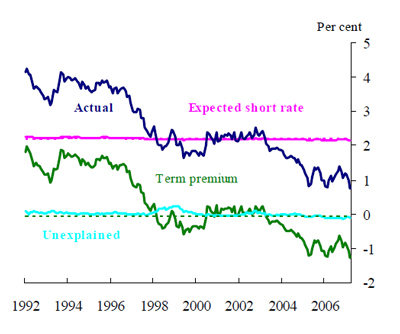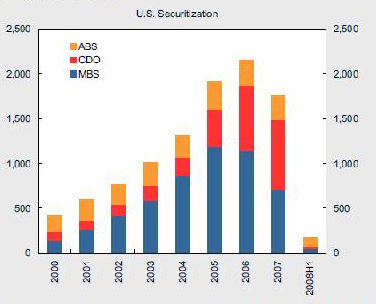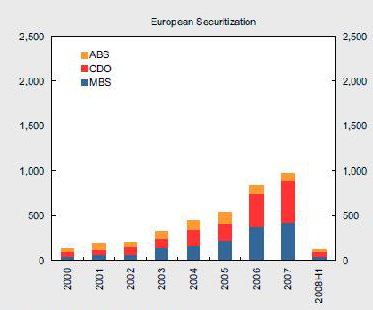Dealbreaker has a highly entertaining commentary on quants, inspired by a somewhat more serious Reuters piece:
Because some of their mathematical models failed to take into account factors that later turned out to be crucial, quants have been blamed for compounding risk and exacerbating the crash in financial markets.
…
The profession’s reputation took a beating in August 2007, when some quant funds — which try to beat the market by crunching vast amounts of data at lightning speed — lost a third of their value in a matter of days.
…
As the mortgage crisis gathered steam last year and financial markets became volatile, quant funds, which make up about 7 percent of the hedge fund universe, were caught flat-footed.
To raise cash, they started selling stocks, which created unusual moves in stock prices, throwing other quant models off. Finally, the selling snowballed into a full market panic.
“Before you know it, you have a chain reaction and the whole market dives on the basis of what amounts to a mathematical prediction,” said Peter Morici an economics professor at the University of Maryland.
“You create a mathematical herd. That’s why so often these schemes based on math models end in tears.”
…
Nassem Taleb, a former trader who wrote the best seller “Black Swan: The Impact of the Highly Improbable,” is even more outspoken. “Quants and quant programs are dangerous to society,” he said.
The failure last year to foresee that subprime borrowers might default on their mortgages is only the latest example of mathematical models that rule out possible sets of circumstances because they were highly unusual.
In 1998, Connecticut hedge fund Long-Term Capital Management collapsed because its mathematical model failed to foresee the Russian debt crisis.
I have found that generalizing about “quants” is not a wise thing to do. There are quants and then there are pseudo-quants; the difference between the two can usually be found only by detailed analysis of the model, preferrably at the code level. I also find the idea of “quant schools” to be somewhat odd. It’s putting the cart before the horse! A more rational way of getting into the area is to do many, many calculations on the back of an envelope, executing your trades according to your model, and making money for your clients. You then realize that if you could do your calculations more rapidly, you could take advantage of shorter-lived anomalies; you also realize that increasing the size of your universe will give you more opportunities to exploit your model. So you end up “crunching vast amounts of data at lightning speed”, but the model is the main thing, not the amount of data or the speed.
I should also point out that the rescuers of LTCM made out like bandits; the relationships were basically valid, it was margin calls caused by transient anomalies that killed them. The danger is not quantitative analysis; the danger is over-leverage. But just try telling a salesman that the idea that “one” is good does not necessarily imply that “two” is better – especially when they can charge a full point to make it “three”!
The August 2007 quant debacle has been previously discussed on PrefBlog. Pseudo-quants got hammered; everybody else made out just fine.
There are fears of a wave of defaults on commercial property:
U.S. commercial properties at risk of default could triple if rental income from office, retail and apartment buildings drops by even 5 percent, a likely possibility given the recession, according to research by New York-based real estate analysts at Reis Inc.
Lenders that used optimistic rent estimates to grant mortgages beginning in 2005 stand to lose as much as $23.1 billion, or 7.02 percent, of total unpaid balances if landlords lose 5 percent of net operating income, according to Reis. Analysts examined data on 22,890 properties that together may account for unpaid loans of about $329 billion in 2009, said Victor Calanog, director of research.
…
Reis estimates at least 353 properties, or 1.5 percent of the total number analyzed, could fall into default as net operating income, mainly from rent, barely clears loan payments.
Properties at risk include those with net operating income less than 1.1 times their loan payment, Calanog said. That “base case” translates to $9.08 billion of unpaid balances, or 2.76 percent of the total dollar value outstanding on the mortgages.
Brookfield is always – well, recently – a hot topic of discussion on PrefBlog, so here are some numbers from the Brookfield Properties 3Q08 Report:
| Nine months to 2008-9-30 |
| |
US
Commercial
Property |
Canadian
Commercial
Property |
| Net Operating Income |
$831-million |
$215-million |
| Interest on Debt |
$445-million |
$35-million |
Income coverage is not the same thing as profitability, of course (there’s depreciation to be covered, among other things), but there is no indication here of impending cash flow difficulties with Brookfield’s consolidated property arm.
Strange and violent action in the CMBS and derivative markets on November 20. I was hoping for some good CMBS colour on Across the Curve, but he’s taking the week off. Huh! I wanted to spend Christmas with my loved ones, too … but the banks are closed.
I’ve argued here interminably that what we want right now by way of fiscal policy is infrastructure spending. Daniel Gros argues on VoxEU that it’s too hard to get shovels in the ground quickly enough and advocates tax cuts and deferrals:
Even in the US, this instrument will only have limited importance, as public infrastructure spending is projected to increase from around 2.6% (in 2007) to 3.6% of GDP (in 2009), thus constituting only a small fraction of the overall deficit, which is now projected to climb to around 8%–9% of GDP.
…
Households that depend on credit to finance their consumption will be most affected by the credit crunch and are thus most likely to react to a tax cut by maintaining their consumption. For this type of household, a tax cut (or an increase in expenditure) will be an effective tool to prevent an even sharper drop in consumption.
…
The fact that the marginal propensity to save is likely to be much higher in countries with solvent households (Germany and most of rest of continental Europe) also implies that the multiplier effect of spending on public infrastructure will also be lower than in the Anglo-Saxon countries where households are close to bankruptcy. This is another reason why the German government should be more hesitant than others to engage in a big fiscal stimulus.
A similar reasoning applies to the corporate sector – in a credit crunch investment will be strongly affected by the liquidity situation of enterprises. This implies that in countries where the corporate sector is a heavy borrower (Spain, France and Italy) it would be important to improve the liquidity situation of enterprises. One simple way to do this would be to allow all corporations to postpone payment of corporate income taxes for 1-2 years. This would not result in higher deficits as usually measured, but the cash deficit would increase as governments would effectively extend a credit to the corporate sector. Such a measure would thus be very different from a tax cut because it would not lead to larger debt levels and thus should not lead to sustainability problems later on. Postponing the payment of corporate income tax would of course help only enterprises that make a profit, but this should be considered an advantage because it would mitigate the impact of the credit crunch for sound enterprises, i.e. those that deserve to be saved. Companies that did not pay corporate income tax because they were not able to turn a profit even during the boom would not benefit, but they are also the most likely ones to be insolvent anyway.
I cannot think that the tax deferral option is realistic. If I managed a large profitable corporation and was told my tax was deferred and would be due in 1-2 years, I wouldn’t rush out and spend the money. Nope. I’d buy some high quality short term bonds, book a little free profit and not increase my business risk.
The direct household stimulus argument is a little harder to deal with; my main point was actually brought up by the author:
Even in the US, where the private savings rate has been close to zero, households still chose to save more than half of the tax rebate decided earlier in 2008.
while my other point is also referred to:
Households that depend on credit to finance their consumption will be most affected by the credit crunch and are thus most likely to react to a tax cut by maintaining their consumption. For this type of household, a tax cut (or an increase in expenditure) will be an effective tool to prevent an even sharper drop in consumption.
See? They’ll just blow it on beer and prostitutes.
A recession is nature’s way of telling us we’ve been doing it wrong … one reason why I think we should be very cautious about bailing out the big automakers. Infrastructure spending – as long as it is genuinely useful infrastructure spending – is the way to go.
The Fed has approved CIT Group’s application to become a bank holding company.
Yet another horrible day for the market, with PerpetualDiscounts losing 1.0128% on heavy volume. That’s its seventh straight losing day … but look at the bright side! There are only two more days of tax-loss selling to go … and one of them a short day … and then I’ll have to think up another rationale!
Note that these indices are experimental; the absolute and relative daily values are expected to change in the final version. In this version, index values are based at 1,000.0 on 2006-6-30.
The Fixed-Reset index was added effective 2008-9-5 at that day’s closing value of 1,119.4 for the Fixed-Floater index. |
| Index |
Mean Current Yield (at bid) |
Mean YTW |
Mean Average Trading Value |
Mean Mod Dur (YTW) |
Issues |
Day’s Perf. |
Index Value |
| Ratchet |
N/A |
N/A |
N/A |
N/A |
0 |
N/A |
N/A |
| Fixed-Floater |
8.59% |
8.74% |
140,047 |
11.90 |
7 |
-0.1272% |
615.1 |
| Floater |
9.41% |
9.49% |
93,396 |
10.02 |
2 |
+0.8637% |
345.4 |
| Op. Retract |
5.58% |
7.04% |
165,970 |
4.10 |
14 |
-0.2140% |
974.5 |
| Split-Share |
6.67% |
12.19% |
96,777 |
3.92 |
15 |
+0.1808% |
925.7 |
| Interest Bearing |
10.10% |
21.39% |
59,444 |
2.64 |
3 |
-2.0792% |
734.8 |
| Perpetual-Premium |
N/A |
N/A |
N/A |
N/A |
N/A |
N/A |
N/A |
| Perpetual-Discount |
8.26% |
8.40% |
245,245 |
11.02 |
71 |
-1.0128% |
673.1 |
| Fixed-Reset |
6.06% |
5.19% |
1,142,358 |
14.66 |
18 |
-0.4395% |
997.9 |
| Major Price Changes |
| Issue |
Index |
Change |
Notes |
| BCE.PR.Y |
Ratchet |
-7.7736% |
|
| BCE.PR.C |
FixFloat |
-7.0370% |
|
| POW.PR.A |
PerpetualDiscount |
-6.7857% |
Now with a pre-tax bid-YTW of 8.99% based on a bid of 15.66 and a limitMaturity. Closing quote 15.66-84, 9×7. Day’s range of 15.58-16.75. |
| BSD.PR.A |
InterestBearing (for now!) |
-6.2344% |
Asset coverage of 0.7+:1 as of December 19, according to Brookfield Funds. Now with a (dubious) pre-tax bid-YTW of 27.82% based on a bid of 3.76 and a (dubious) hardMaturity 2015-3-31 at 10.00. Closing quote of 3.76-99, 29×5. Day’s range of 3.75-85. |
| BNA.PR.C |
SplitShare |
-6.0526% |
Asset coverage of 1.7+:1 based on BAM.A at 18.05 and 2.4 BAM.A per preferred. Now with a pre-tax bid-YTW of 23.07% based on a bid of 7.14 and a hardMaturity 2019-1-10 at 25.00. Closing quote of 7.14-00, 3×46. Day’s range of 7.60-10. |
| PWF.PR.G |
PerpetualDiscount |
-5.6604% |
Now with a pre-tax bid-YTW of 8.89% based on a bid of 17.00 and a limitMaturity. Closing quote 17.00-50, 1×14. Day’s range of 17.35-75. |
| RY.PR.A |
PerpetualDiscount |
-4.9967% |
Now with a pre-tax bid-YTW of 7.93% based on a bid of 14.26 and a limitMaturity. Closing quote 14.26-77, 4×3. Day’s range of 14.26-01. |
| POW.PR.B |
PerpetualDiscount |
-4.4987% |
Now with a pre-tax bid-YTW of 9.05% based on a bid of 14.86 and a limitMaturity. Closing quote 14.86-29, 5×6. Day’s range of 14.85-51. |
| HSB.PR.C |
PerpetualDiscount |
-4.1060% |
Now with a pre-tax bid-YTW of 8.88% based on a bid of 14.48 and a limitMaturity. Closing quote 14.48-99, 5×6. Day’s range of 14.00-15.20. |
| BNS.PR.J |
PerpetualDiscount |
-3.9542% |
Now with a pre-tax bid-YTW of 8.01% based on a bid of 16.76 and a limitMaturity. Closing quote 16.76-99, 2×8. Day’s range of 16.41-35. |
| NA.PR.N |
FixedReset |
-3.9409% |
|
| NA.PR.K |
PerpetualDiscount |
-3.6551% |
Now with a pre-tax bid-YTW of 8.85% based on a bid of 16.87 and a limitMaturity. Closing quote 16.87-24, 7×3. Day’s range of 16.87-75. |
| NA.PR.M |
PerpetualDiscount |
-3.5577% |
Now with a pre-tax bid-YTW of 8.68% based on a bid of 17.62 and a limitMaturity. Closing quote 17.62-95, 2×1. Day’s range of 17.61-47. |
| RY.PR.I |
FixedReset |
-3.4706% |
|
| TD.PR.A |
FixedReset |
-3.3708% |
|
| RY.PR.E |
PerpetualDiscount |
-3.2542% |
Now with a pre-tax bid-YTW of 8.02% based on a bid of 14.27 and a limitMaturity. Closing quote 14.27-55, 15×10. Day’s range of 14.20-96. |
| TD.PR.P |
PerpetualDiscount |
-3.0795% |
Now with a pre-tax bid-YTW of 7.75% based on a bid of 17.31 and a limitMaturity. Closing quote 17.31-50, 2×20. Day’s range of 17.07-85. |
| BMO.PR.H |
PerpetualDiscount |
+3.5958% |
Now with a pre-tax bid-YTW of 8.06% based on a bid of 16.71 and a limitMaturity. Closing quote 16.71-89, 1×3. Day’s range of 16.05-91. |
| FTN.PR.A |
SplitShare |
+4.2199% |
Asset coverage of 1.4-:1 as of December 15 according to the company. Now with a pre-tax bid-YTW of 9.03% based on a bid of 8.15 and a hardMaturity 2015-12-1 at 10.00. Closing quote of 8.15-23, 29×5. Day’s range of 7.92-15. |
| BCE.PR.G |
FixFloat |
+4.6512% |
|
| IAG.PR.A |
PerpetualDiscount |
+4.7581% |
Now with a pre-tax bid-YTW of 8.78% based on a bid of 13.21 and a limitMaturity. Closing quote 13.21-44, 4×11. Day’s range of 13.16-14.43. |
| Volume Highlights |
| Issue |
Index |
Volume |
Notes |
| RY.PR.F |
PerpetualDiscount |
183,745 |
Scotia crossed 130,000 at 14.58. Now with a pre-tax bid-YTW of 7.80% based on a bid of 14.50 and a limitMaturity. |
| RY.PR.C |
PerpetualDiscount |
93,975 |
Scotia crossed 69,500 at 15.30. Now with a pre-tax bid-YTW of 7.77% based on a bid of 15.05 and a limitMaturity. |
| SLF.PR.E |
PerpetualDiscount |
78,540 |
Desjardins bought two blocks from Nesbitt, of 10,000 and 12,200 shares, both at 12.50. Now with a pre-tax bid-YTW of 9.16% based on a bid of 12.40 and a limitMaturity. |
| GWO.PR.H |
PerpetualDiscount |
73,750 |
Scotia crossed 49,000 at 14.31. Now with a pre-tax bid-YTW of 8.67% based on a bid of 14.10 and a limitMaturity. |
| BNS.PR.O |
PerpetualDiscount |
70,640 |
National crossed 20,000 at 18.91. Now with a pre-tax bid-YTW of 7.56% based on a bid of 18.91 and a limitMaturity. |
There were ninety-one other index-included $25-pv-equivalent issues trading over 10,000 shares today.



